
|
![]()
Greatest Films of the 1940s
1940 | 1941 | 1942 | 1943 | 1944 | 1945 | 1946 | 1947 | 1948 | 1949
Title Screen Film Genre(s), Title, Year, (Country), Length, Director, Description 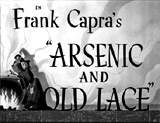

Arsenic and Old Lace (1944), 118 minutes, D: Frank Capra
A hilariously-funny, frantic farce and black comedy - a frenzied adaptation of the smash Broadway comedy from 1941 to 1944, with three of the stage performers reprising their roles. Set around Halloween night in Brooklyn, two sweet old spinster ladies, Abby (Josephine Hull) and Martha Brewster (Jean Adair) poisoned lonely gentlemen male callers in their Brooklyn home as mercy killings. They served them homemade elderberry wine and then buried them (with Christian burials) in their cellar. Their hapless nephew Mortimer Brewster (Cary Grant), a mild mannered drama critic with a frustrated new wife Elaine Harper (Priscilla Lane), discovered what was going on when he found a dead body in the window seat - and there were twelve more in the basement. He mistakenly believed that his crazy eccentric brother "Teddy Roosevelt" Brewster (John Alexander), who was digging cellar graves for Panama Canal yellow fever victims, was responsible and wanted to get him safely committed, never even suspecting his two aunts. Teddy regularly charged up the stairs with a bugle in hand. Mr. Witherspoon (Edward Everett Horton), the director of the Happydale Sanitorium rest home was reluctant to accept Teddy, because he already had too many "Roosevelts." Mortimer was also confronted by the unexpected arrival of his sinister, psychotic murderous brother on the lam, Jonathan Brewster (Raymond Massey in the film, Boris Karloff on stage) who had a body of his own. Jonathan was accompanied by another villainous companion, Dr. Einstein (Peter Lorre). At the film's end, Mortimer's final words about his real heritage were censored from " I'm a bastard!" to "I'm the son of a sea cook!"



A Canterbury Tale (1944, UK), 124 minutes, D: Michael Powell, Emeric Pressburger
This eccentric and lyrical UK film was advertised with the tagline: "Four modern pilgrims in a story of today - yet away from war." The story, set in the summer of 1943 during the early years of WWII, began with three individuals (or pilgrims) arriving, during a blackout, in the small Kent village of Chillingbourne in Southern England, enroute toward Canterbury: (1) Alison Smith (Sheila Sim) a London department store salesgirl about to become a "Land Girl" in the Women's Land Army, (2) US Army Sgt. Bob Johnson (John Sweet), a GI serviceman on leave, and (3) cynical Peter Gibbs (Dennis Price), a drafted Englishman and former cinema-organist who gave up his music school dreams. As they departed the train and entered town after dark, a strange nocturnal "Glue Man" poured sticky glue into Alison's hair - she was his 11th victim. As they investigated the incident, they became suspicious of the eccentric local magistrate, Thomas Colpeper JP (Eric Portman), also a farmer whom Alison was to begin working with. They also studied the history of the area and tales of The Pilgrim's Way, and attended Colpeper's lantern-slide lecture. By the film's conclusion once they reached Canterbury (in a modern-day pilgrimage) about a ten minute journey away by train, Colpeper had admitted to being the Glue Man - with good intentions - to assure that local girls wouldn't go out at night with GIs and forsake their husbands and boyfriends, and to hopefully guarantee that they would learn about the area's history. Each of the three pilgrims also miraculously received a blessing in Canterbury and were changed forever. Both Alison and Bob, who feared that their missing fiancee/girlfriend was dead, located their loved ones. And Peter Gibbs played the organ in Canterbury's mystical cathedral.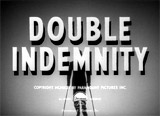



Double Indemnity (1944), 106 minutes, D: Billy Wilder
One of the greatest, darkest film noirs of all time and one of the best suspense/thriller films of the 40s, with a brilliant script based on the 1943 crime novel by James M. Cain, written by Raymond Chandler and Billy Wilder. In the novel, the main characters were named Walter Huff and Phyllis Nirdlinger. Told in a flashback by the wounded protagonist (with a tense voice-over narration), insurance salesman Walter Neff (Fred MacMurray) fell hard for a blonde-wigged, sexy housewife named Phyllis Dietrichson (Barbara Stanwyck) with a sexy anklet. The femme fatale enticed him into a scheme to murder her husband, in order to fraudulently collect a double indemnity accident policy pay-off. Claims agent Barton Keyes (Edward G. Robinson), a perceptive, dogged co-worker in Walter's insurance company, became suspicious and unraveled the case. In the uncompromising ending, the two lovers plotted against each other.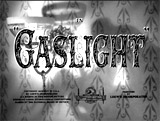


Gaslight (1944), 113 minutes, D: George Cukor
A classic, lavishly glossy, pseudo-Victorian thriller from MGM. A remake of director Thorold Dickinson's shorter and more faithful Gaslight (1940), with Anton Walbrook and Diana Wynyard, which MGM unsuccessfully tried to destroy to avoid competition. [Note: It was called Angel Street when it played on Broadway beginning in late 1941, with Vincent Price in the villainous role. Patrick Hamilton's famous play originally opened on the stage in London in 1939.] In London, Paula Alquist (Best Actress Oscar-winner Ingrid Bergman), a wealthy, vulnerably-innocent socialite married a charming ne'er-do-well, urbane, worldly Londoner Gregory Anton (Charles Boyer). She was convinced to move into her murdered Aunt's ancestral home. (Anton killed the Aunt years earlier). He was determined to drive his wife mad to get the inheritance - obsessed with finding her Aunt's hidden jewelry in their house. The menacing Anton methodically victimized and terrorized his wife by playing upon her memory lapses and by tricking her with dimming gaslights and unsettling sounds from the attic, until savvy Scotland Yard detective Brian Cameron (Joseph Cotten) entered the case and realized Paula was deliberately being tormented. The saucy, teenage maid Nancy Oliver was 17 year-old Angela Lansbury in a supporting role - her film debut.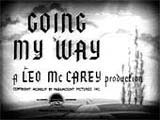



Going My Way (1944), 130 minutes, D: Leo McCarey
A classic Bing Crosby film and a major box-office hit (the top-grossing film of the year) - and a Best Picture winner. It was followed by the sequel, The Bells of St. Mary's (1945). A heartwarming, sentimental story of a young, personable, progressive, down-to-earth priest Father Chuck O'Malley (Bing Crosby) who worked in a poor New York slum Catholic parish - the financially-struggling St. Dominic's Church. He sought to win over his strict, loveable, but crusty, conservative old parish priest Father Fitzgibbon (Barry Fitzgerald, uniquely nominated for both Best Actor and Best Supporting Actor, winning the latter) and to teach a group of street kids responsibility and respect by organizing a boys choir. Crosby's songs included the incomparable "Swinging on a Star" (Oscar-winning), "Ave Maria," "Three Blind Mice" (sung with the boys' choir) and the Irish lullaby "Too-ra-Loo-ra-Loo-ra."

Hail the Conquering Hero (1944), 101 minutes, D: Preston Sturges
A fast paced, zany satire on war-time patriotism and hysteria, human nature, motherhood, and hero-worship from writer/producer/director Preston Sturges. With a memorable screen performance for Eddie Bracken, in a Paramount Studios film that was daring for its time. World War II Marine Corps 4-F reject (due to chronic asthma or hay fever) Woodrow Lafayette Pershing Truesmith (Eddie Bracken), ashamed and embarrassed to admit his lack of fitness for duty, masqueraded as a soldier - he worked in a shipyard but wrote deceptive letters home telling of his military exploits. He allowed a group of sympathetic soldiers on board a train to pass him off as a true war hero, to deceive his hometown folks when he returned home in a great homecoming sequence, complete with brass bands. In the small town of Oakridge, Woodrow was "hailed as the conquering hero" and lauded for his bravery at Guadalcanal. Woodrow's former girlfriend Libby (Ella Raines) was now engaged to Forrest Noble (Bill Edwards) (also discharged for hay fever). Woodrow was ashamed to renew their love (he told her that he had met someone else). After a sleepless night, Woodrow confessed to all the falsehoods, and to his surprise, he was commended for his courage, and he won back his girlfriend. The townsfolk even nominated him for mayor to replace the current corrupt one Mayor Noble (Raymond Walburn).


(King) Henry V (1944, UK) (aka The Chronicle History of King Henry the Fift with His Battell Fought at Agincourt in France), 136 minutes, D: Laurence Olivier
A triumphant, colorful, costume drama/spectacle of the 15th century monarch - the first screen adaptation of William Shakespeare's classic, timeless and immortal epic play. Olivier was given an Honorary Oscar as actor, producer and director in bringing Henry V to the silver screen. Remade by director/star Kenneth Branagh as Henry V (1989, UK) covering the same play and the same level of directorial ability and a similar level of acting skill by the ensemble cast. The nature of both films was deeply affected by the historical context in which they were created. Both were about young, 15th century, 28 year-old Plantagenet Prince of Wales (Laurence Olivier) who decided to act on his claim to the French throne by invading France, and won a victory at the crucial Battle of Agincourt against a larger, vastly superior French force. The story was told by actor/director Laurence Olivier (in his directorial debut, who also starred, co-produced, and co-adapted the script) in Technicolor (aka The Chronicle History of King Henry the Fift with His Battell Fought at Agincourt in France) - the first radical reinterpretation of the play. Innovatively staged, it was intimate and theatrical (the film opened on a bare Elizabethan stage, the Globe Theater, in the style of a play in the 1600s, and then expanded outward from there). The narrative then shifted to an epic film format shot on-location with sweeping, technicolor battle scenes. The film was chiefly about royal responsibility, war and its effects. The film was deeply affected by the historical context in which it was created -- Olivier had intended Henry V to be a rallying morale booster for Britain at the height of WWII. Highlights included Henry V's pre-battle speech to his troops at the siege of Harfleur, from Act III, Scene 1, beginning with the stirring line: "Once more unto the breach, dear friends, once more; or close the wall up with our English dead," and his St. Crispin's Day address to his battle-weary men, from Act IV, Scene 3, "We few, we happy few, we band of brothers. For he today that sheds his blood with me shall be my brother." Academy Award Nominations (1946): 4, including Best Picture, Best Actor--Laurence Olivier, Best Color Art Direction-Interior Decoration, Best Music Score--William Walton.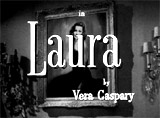



Laura (1944), 88 minutes, D: Rouben Mamoulian/Otto Preminger
A gripping, moody, stylish murder mystery, a classic, complex film noir and tale of romance with sharp and witty dialogue, with a great ensemble group of character actors. Based on the 1943 novel by Vera Caspary. Winner of the Best Black/White Cinematography Academy Award, and with the haunting melody of the title theme song, David Raskin's "Laura." The film contained unsettling, obsessive undertones of voyeurism and ghoulish necrophilia. It opened with the voice of a prissy, acerbic, cynical newspaper columnist named Waldo Lydecker (Clifton Webb) (purportedly based upon columnist, broadcaster, and The New Yorker theater critic Alexander Woollcott) who unfolded the story in flashbacks. Street-wise police detective Mark McPherson (Dana Andrews) investigated the shotgun slaying/murder of a beautiful young socialite Laura Hunt (Gene Tierney) - her face had been blown away. During his interviews and work on the case, he became personally absorbed in the details of the young woman's life and found himself irresistibly falling in love with a large portrait of the mysterious victim and his pieced-together image of her. The detective's earthy directness and toughness was contrasted to the smug, pseudo-intellectualism of the victim's upper crust, socially-prominent friends in Manhattan, including Laura's mentor Lydecker, and Laura's fiancee - an effeminate gigolo named Shelby Carpenter (Vincent Price). It was revealed that the murdered girl was not Laura, but Diana Redfern, after Laura returned from a long weekend. In the exciting conclusion, enraged and jealous Lydecker (who had killed Diana) threatened Laura with a shotgun (originally hidden in a clock) in her apartment with a murder/suicide, but was felled by police. He expired with the words: "Goodbye, Laura. Goodbye, my love."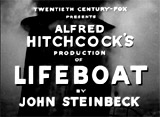



Lifeboat (1944), 96 minutes, D: Alfred Hitchcock
Novelist John Steinbeck co-scripted the screenplay with Jo Swerling for this World War II melodrama/thriller - an interesting, visually-arresting, penetrating study of human nature and class distinctions under pressure. Steinbeck's 100 page unpublished novella was adapted for the screen by American scripter Jo Swerling. This was the only film that Hitchcock made for Twentieth Century Fox Studios. Hitchcock's famed cameo was ingenious - he appeared in before and after photos in a newspaper ad for a dieting product. The action was contained entirely aboard one small cramped lifeboat in the North Atlantic, as a group of survivors of a torpedoed freighter struggled together. [Note: The film was shot entirely on a restricted set - on a boat in a large studio tank.] All came from the same Allied boat, sunk by a German submarine/U-boat, except for one rescued German (the captain of the sunken submarine). Sharp characterizations were developed between the surviving characters from various backgrounds who suspensefully clashed and conspired with each other: a chic, spoiled, fashion journalist named Constance 'Connie' Porter (Tallulah Bankhead), a proletarian seaman John Kovak (John Hodiak), and the devious German captain of the U-boat Willy (Walter Slezak) who cleverly manipulated them to his own advantage as helmsman of the lifeboat. When the survivors finally discovered Willy's deceptions and cruelty (he killed injured, amputee seaman Gus Smith (William Bendix) and was hoarding water), they beat him to death and threw him overboard - while lamenting: "What do you do with people like that?" When the group was finally awaiting rescue by an allied warship, they had to make a decision about saving another young, wounded German survivor.

Meet Me in St. Louis (1944), 113 minutes, D: Vincente Minnelli
One of MGM's greatest, most elegant, and most popular musicals of all-time - and MGM's second most-successful film after Gone With the Wind (1939) in its 20 year history. It was the second highest-grossing film of 1944 as well. The nostalgic, romantic, heartwarming film was the story of the Smith family in turn-of-the-century St. Louis in the year before the 1904 World's Fair. The Technicolored film reestablished star Judy Garland's career - and set her up to become director Minnelli's future wife. The action surrounded the emotions which erupted in the happy Smith family, a typical idealized Americana family group, with the news of the family's impending move to New York due to father Alonzo Smith's (Leon Ames) job transfer. Mrs. Anna Smith (Mary Astor) and the four daughters and son, including eldest daughter Rose (Lucille Bremer), Esther (Judy Garland), Agnes (Joan Carroll) and the precocious, morbid youngest daughter "Tootie" (Margaret O'Brien), and Lon Jr. (Henry H. Daniels, Jr.) wanted to remain, especially because of the females' possible romantic futures with boyfriends. Esther was in love with boy next door John Truett (Tom Drake), and she sang most of the film's sentimental songs, including "The Boy Next Door," "Have Yourself a Merry Little Christmas," and "The Trolley Song." In the film's upbeat ending, Mr. Smith announced that because of the devastating upset he had caused by proposing a move, he decided that the family would not leave St. Louis.


The Miracle of Morgan's Creek (1944), 99 minutes, D: Preston Sturges
One of director/writer Preston Sturges' top war-time screwball comedies (although not as successful as The Lady Eve (1941) or The Palm Beach Story (1942)). Writer/director Frank Tashlin's loose remake Rock-A-Bye Baby (1958) with Jerry Lewis was based on this film. It was considered a defiant, controversial, bold, irreverent farce at the time due to its scandalous content skewering marriage, parenthood, motherhood and the family, while also containing Sturges' characteristic touches - fast-delivered dialogue and slapstick. A hapless, small-town girl from Morgan's Creek, flirty blonde Trudy Kockenlocker (Betty Hutton) (still considered a minor at under 21 years of age) attended a rollicking, all-night farewell party with servicemen from the local army base, got drunk, and married a soldier. She soon found herself pregnant, but couldn't remember which soldier she had married - was his name something like "Ignatz Ratzkiwatzki...or was it Zitzkiwitzki"? And she feared her strict, exasperated and overprotective father Constable Kockenlocker (William Demarest). With the conniving advice of her shrewd 14 year-old sister Emmy (Diana Lynn), the mother-to-be convinced average guy - bank-clerk/4-F reject Norval Jones (Eddie Bracken), Trudy's childhood boyfriend, to marry her and pretend to be the father. Norval made a crucial error when he signed his real name on the marriage certificate, and he faced arrest on 19 counts (forgery, false impersonation, corrupting the morals of a minor, even bank robbery and kidnapping). Before the frantic film ended, Trudy 'miraculously' gave birth to sextuplets (six baby boys) on Christmas Day, and Norval was given assistance by Governor McGinty (Brian Donlevy) and The Boss (Akim Tamiroff) (both actors from Sturges' previous film The Great McGinty (1940)). McGinty ordered Norval released from jail, declared him and Trudy married, promoted Norval into the National Guard and made Trudy's father police chief. The young couple became national celebrities, but Norval fainted when he learned he was the father of six offspring ("But Norval recovered and became increasingly happy for, as Shakespeare said: "Some are born great, some achieve greatness, and some have greatness thrust upon them.'")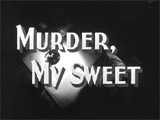




Murder, My Sweet (1944), 95 minutes, D: Edward Dmytryk
Originally released with the title Farewell, My Lovely, although changed so that fans of 30s song-and-dance star Dick Powell, portraying the main character, wouldn't think the film was a musical comedy. This film marked the earliest screen depiction of detective Philip Marlowe. [Note: Philip Marlowe was introduced in 1939 in Chandler's first novel The Big Sleep, which was made into a movie in 1946 with Humphrey Bogart in the role.] This film was remade with the original title, Farewell, My Lovely (1975) starring Robert Mitchum. The tales were adapted from Raymond Chandler's 1940 hard-boiled novel - a superb, complex, shadowy film noir of murder, corruption, blackmail, double-cross and double identity, with witty dialogue and cynical, descriptive voice-over narration. The convoluted film opened in wartime Los Angeles, where tough yet vulnerable, blindfolded/bandaged gumshoe detective Philip Marlowe (played by 30s musical crooner Dick Powell in a dramatic role switch) was grilled under a bright light by police interrogators. In flashback (almost the entire film), he told a disorienting and bewildering tale. He had been hired by recently-released, brutish, urgent ex-con Moose Malloy (Mike Mazurki) to search for his missing girlfriend Velma Valento (Claire Trevor). And then he was also commissioned as a bodyguard, for $100 to accompany an effeminate man Lindsay Marriott (Douglas Walton) (associated with shady underworld figure Jules Amthor (Otto Kruger)) during a ransom payoff of $8,000 for allegedly stolen jewels. When Marriott was killed, Marlowe was knocked unconscious. The owner of the jewels, a mysterious, flirtatious Mrs. Helen Grayle (Trevor again) hired him to locate her allegedly stolen jade necklace (not actually stolen in the end) worth $100,000, originally given to her by her older wealthy husband Mr. Grayle (Miles Mander). Marlowe also met Ann (Anne Shirley in her final film), Mrs. Grayle's pretty red-haired stepdaughter. Marlowe continued to navigate through a perilous world, becoming further entangled with and threatened by despicable high- and low-class criminals. During a meeting with Amthor, Marlowe was blackjacked unconscious. He experienced drug-induced hallucinations and nightmares ("a crazy, coked-up dream") when pursued through a series of identical doors by a man with a giant hypodermic needle, during imprisonment in a strange sanitarium run by Dr. Sonderborg (Ralf Harolde). After escaping, he became the prime suspect for Marriott's murder while continuing to conduct his investigation. He also became embroiled when Amthor was found in his penthouse with a snapped neck committed by the brutish Moose Malloy. What followed were two scenes in the Grayle beach house, the first when Helen tried to seduce Marlowe and convince him to help her. There was also a final standoff and violent shoot-out, when it was revealed that mysterious, flirtatious, gold-digging double-identity Mrs. Helen Grayle - also known as Moose's missing Velma, had set up numerous individuals over the theft of her jade jewelry. She was indeed a murderous femme fatale - she was the one who had murdered Marriott. The jealous Mr. Grayle shot Helen dead (with Marlowe's gun), and Moose in anger retaliated - and both Moose and Mr. Grayle also ended up dead. Marlowe was temporarily blinded by gunshot powder close to his face. In the film's ending back in the present after Marlowe's tale ended, he was reunited with cute love interest Ann in the back of a taxi-cab.


National Velvet (1944), 125 minutes, D: Clarence Brown
One of MGM's greatest children's/family films - an all-time, loveable, dramatic film favorite in Technicolor. This film launched Elizabeth Taylor's career, in her first starring role. Co-star Mickey Rooney also starred in a similar role in The Black Stallion (1979). This film was remade as International Velvet (1978) starring Tatum O'Neal. The screenplay by American screenwriter Helen Deutsch was based on the 1935 novel by Enid Bagnold. It was the poignant and uplifting story of a plucky young daughter in Sussex, England, the middle child in the Brown family, headed by a pragmatic butcher Mr. Brown (Donald Crisp) and his strong, plain-spoken and observant wife (Ann Revere). In the 1920s, young horsewoman Velvet Brown (12 year-old Elizabeth Taylor) won a neighbor's unruly, spirited and wild horse named "The Pie" in a village raffle-lottery. Determined, she trained the horse with the coaching help of a homeless, embittered, ex-jockey Mi Taylor (Mickey Rooney) to enter the famed Grand National Steeplechase Race. (Mi continued to feel responsible for an accident that had killed a jockey.) Against everyone's wishes and impossible odds, Velvet replaced her jockey Taski (Eugene Loring) and, in disguise as a male rider, she took charge of her own horse and won the race in the exciting, beautifully-edited conclusion. However, she was disqualified after crossing the winning line, because she fainted and fell off her horse. Upon their return to the village, they were honored and greeted ceremoniously. One of many offers for appearances and interviews was to have Velvet and Pie travel to Hollywood to star in a motion picture - but she rejected the idea.

None But The Lonely Heart (1944), 113 minutes, D: Clifford Odets
Playwright Clifford Odets wrote and directed this unusual, daring melo-drama of Richard Llewelyn's 1943 novel - it was Odets' directorial and scripting debut. Cary Grant's indomitable performance in the depressing drama earned him his sole Oscar nomination - his straightest dramatic role in his entire career, although he believed he was miscast. The film turned out to be a flop for RKO Studios. In London's East End slums of the 1930s, a young, witty, but lazy and irresponsible Cockney drifter Ernest "Ernie" Verdun Mott (40 year-old Cary Grant) lacked conscience and was solely interested in self-satisfaction. He was carefree and restless, basically a wandering, shiftless, no-good young man. He joined a band of thieves committing petty crimes, briefly associated himself with fellow cello-playing musician and neighbor Aggie Hunter (Jane Wyatt) who cared for him, and instead took a romantic interest in gangster friend Jim Mordinoy's (George Coulouris) fickle ex-wife Ada Brantline (June Duprez). (Later, he learned that she had a baby daughter from her marriage). When Ernie learned that his poverty-stricken, widowed mother Ma Mott (Ethel Barrymore), the proprietor of a second-hand furniture shop/pawn shop, was terminally ill and dying of cancer - he returned home. He became a devoted son and his spirit was semi-transformed when he helped run the shop and care for Ma. However, his mother began to also get involved with Ernie's wayward crime friends, including shoplifter Mrs. Jane Snowden (Queenie Vassar). After being tempted, she agreed to fence stolen goods for the shoplifter, to help raise money for her poor family. At the same time, Ernie continued to be engaged in criminal activities with his companions - mostly car-theft. During one altercation with police following a crime, they searched him and found a platinum cigarette case - he claimed it was given to him by his mother as a birthday gift. The item was traced and found to be stolen goods. In the film's tragic conclusion, the dying Ma was arrested and jailed. She begged Ernie's forgiveness for disgracing the Mott family name before dying in prison. Ernie was forlorn after Ada decided to return to her ex-husband, so he ventured out to find Aggie.


Since You Went Away (1944), 172 minutes, D: John Cromwell
A big-budget, sentimental soap opera of a genteel, idealized Midwestern family left on the home front in 1943 during World War II. At the time, it was the longest and most expensive Hollywood film since producer David O. Selznick's own Gone with the Wind (1939). Selznick also wrote the screenplay, based upon Margaret Buell Wilder's 1943 novel "Since You Went Away: Letters to a Soldier from His Wife" - a collection of letters to her overseas husband while he was away at war. The touching film epitomized Hollywood's effort to boost morale during the war, with vignettes showing the effects of rationing, personal sacrifices, and the many reunions and departures. The family's individual tragedies and problems were presented in this classic, melodramatic weeper, with a great Oscar-winning score from Max Steiner. In the all-star cast were matriarchal Anne Hilton (Claudette Colbert) who held her family of two teenaged daughters together - Jane (Jennifer Jones) and Bridget (or Brig) (teenaged Shirley Temple) - when their beloved businessman father, who volunteered to serve, was reported lost and missing in action. Jane romanced shy sailor Cpl. William G. 'Bill' Smollett II (Robert Walker, Jennifer Jones' real-life husband at the time, although she would soon divorce and marry producer Selznick) - the sweethearts' railroad station parting scene was one of the most unforgettable, tear-jerking sequences of all-time. To help with increasing economic hardships, the Hilton family took on a boarder - family friend Navy Lieutenant Commander Anthony "Tony" Willett (Joseph Cotten), who became the focus of the anxious emotional feelings and tribulations of the family during war-time. Harsh war-time realities came into focus with the death of Jane's young boyfriend during combat.



To Have and Have Not (1944), 100 minutes, D: Howard Hawks
A film loosely based on Hemingway's 1937 novel, with a screenplay co-written by William Faulkner. The film's story was overshadowed by the on-screen and off-screen romance of stars Humphrey Bogart and Lauren Bacall, the first of four films they made together. Their most famous scene was in this romantic drama - the "You know how to whistle, don't you Steve?" scene. Bogart's role as fishing boat captain Harry Morgan closely resembled his role as disaffected Rick Blaine in Casablanca (1942). During World War II in 1940 on the French island of Martinique in Fort-de-France, governed by the Vichy government, ex-patriate Harry Morgan (Humphrey Bogart), charter boat owner of the Queen Conch, preferred to remain uncommitted and refused to take sides in the war, accompanied by his alcoholic sidekick (Walter Brennan) (known for saying: "Was you ever bit by a dead bee?") The most remembered feature of the film was the sultry, electrically-sizzling romance that was generated between Harry and stranded American Marie "Slim" Browning (19 year old Lauren Bacall in her film debut and first film with Bogart), a sexy lounge singer who often was accompanied by piano player Cricket (Hoagey Carmichael). Against his own better judgment, Harry was convinced to change his mind and fight the Nazis, and in the process secured enough money to pay for Marie's ticket back to the US. He helped transport Free French Resistance leader Paul De Bursac (Walter Szurovy) and his beautiful wife Mme. Hellene de Bursac (Dolores Moran) to Martinique. The transport wasn't entirely successful - De Bursac was wounded, and Harry's boat was identified by Vichy authorities. Harry, Marie, and Eddie were forced to leave Martinique, and take the De Bursacs to Devil's Island, to help rescue another freedom fighter.




The Uninvited (1944), 98 minutes, D: Lewis Allen
This was a spooky, eerie, unusual, and suspenseful ghost story from Paramount Studios, advertised with the tagline: "From the Most Popular Mystery Romance since "Rebecca"! - and it even had a lesbian subtext. The tale was based on Irish writer Dorothy Macardle's 1941 novel The Easy Freehold (aka Uneasy Freehold). This film was followed by the murder mystery sequel, The Unseen (1945). In 1937, music critic/composer Roderick ("Rick") (Ray Milland) and his sister Pamela Fitzgerald (Ruth Hussey) purchased an empty Gothic house on the English Cornish coast in Devonshire for an unusually low price from Cmdr. Beech (Donald Crisp). Soon after moving in, they experienced strange phenomena and disturbances in the haunted house, dubbed the Windward House: unexplainable cold spots, the smell of mimosas, flickering candles, the sound of a woman crying, pages turning by themselves, wilting flowers, and creaking doors which closed by themselves. They met a local young woman, 20 year-old Stella Meredith (Gail Russell) with long deceased parents who was impulsively drawn to the house. She was the grand-daughter of Cmdr. Beech, but he had forbidden her to visit due to unpleasant past memories. The house was supposedly haunted by Stella's dead mother Mary Meredith (Lynda Grey as ghost), Cmdr. Beech's daughter. Mary was mysteriously killed many years earlier in a fall from the cliffs. The couple tried to help Stella discover the answer to the mystery of the house's uninvited haunting, while Rick fell in love with her. [Note: In the twisting plot, it was learned that Stella's artistic father Llewellyn, although married to Mary, was in a loveless relationship. He was having an extra-marital affair with his gypsy Spanish girl model Carmel. The secret to the mystery was that Carmel was actually Stella's birth mother. A pregnant Carmel was sent to Paris while the pregnancy was kept quiet, and she was to remain there permanently, while the Merediths presumably planned to adopt the child back in England, because the saintly Mary objected to motherhood. However, Carmel couldn't stay away from her child. When Stella was a 3 year-old toddler, Mary and Carmel fought together at the side of the cliff when Mary attempted to murder Carmel's child, and Mary fell to her death. Carmel died shortly later of pneumonia. Stella's father Llewellyn died when Stella was 17.] In the film's conclusion, Cmdr. Beech was shocked to see the ghost of Mary and suffered a fatal heart attack. The mystery was solved when it was found that there were two ghosts that had reappeared, mimosa-scented Carmel's ghost (Betty Farrington as ghost voice) and Mary's angry and malevolent ghost. The ghost of Carmel was there to warn Stella and shield her from harm, and the other one of Mary was there to seek vengeance. The power of the ghost of Mary was neutralized when Rick confronted her: "We're not frightened of you anymore," and the haunting ghost disappeared (and with the threat gone, Carmel also vanished). A shaken but relieved Rick gave Stella the humorous closing line regarding Mary: "Well, I've had a narrow escape. She might have been my mother-in-law."